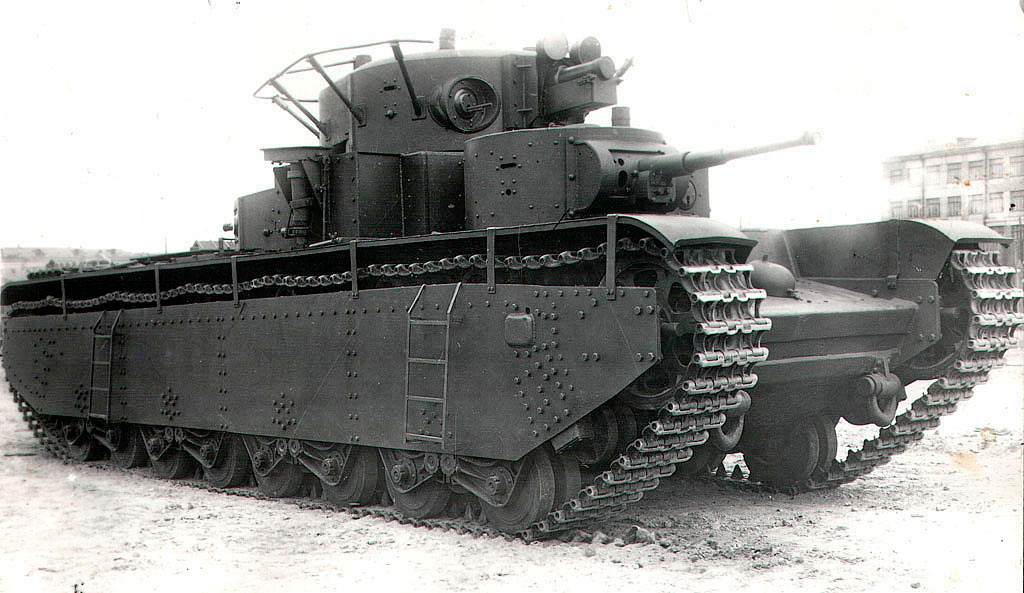
The T-35 is a Soviet heavy tank of insane proportions, with five turrets, five machine guns, three cannons, a crew of 12 and a length exceeding that of even the TOG 2. Built to take on enemies in all directions at once, it ended up as little more than a propaganda tool for Soviet parades.
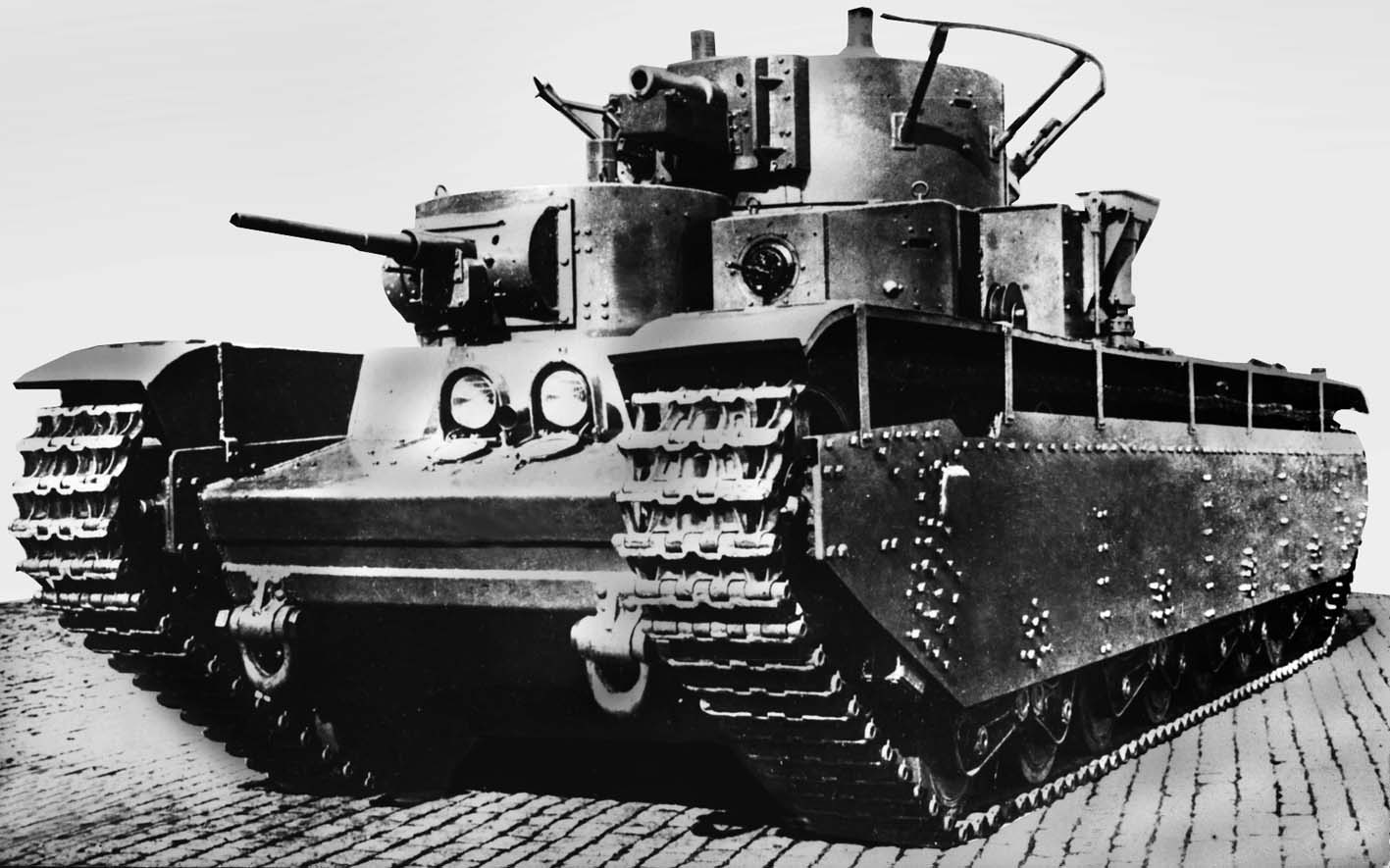
The T-35 has a long, complex and fascinating story, and it laid the groundwork for all of the Soviet heavy tanks that would come after it.
Its dominating appearance in parades led to it becoming a symbol of Soviet military strength, but when it finally engaged in battle it was exposed as being a useless relic built for a different war.
This is the story of the Soviet Union’s embarrassing heavy tank.
Background
In the years following the First World War, the role and layout for the tank had not yet been established. With minimal previous experience and knowledge to build upon, designers were essentially writing the book on what a tank should do, and perhaps more importantly, not do.
One of the defining ideas of this period was adding multiple turrets onto tanks. There was logic behind this, which related to how those at the time thought tanks should be used. As larger tanks were often regarded as tools used for breaking through an enemy position, multiple turrets would enable the crew to engage multiple targets in different directions at once.
Besides, ships had carried independently-operated weapons for centuries.

A number of nations dabbled with this concept, with Britain making one of the most significant; the Vickers A1E1 Independent. The development of this tank began in the early 1920s. It had an astonishing five turrets, with a large, central turret containing a 47 mm gun surrounded by four smaller machine gun turrets.
Read More The SU-14 is a Massive Soviet SPG from the 1930s
In 1926 a single example of the A1E1 was built, and the 35-ton tank quickly gained international attention as a revolutionary design. In reality though the A1E1 was unreliable, and it taught the British first-hand that multi-turreted tanks were impractical.

The commander’s job of observing the battlefield, giving instructions to the driver and directing five turrets was simply too much for one person. So although many had believed in the idea of a tank rolling into an enemy position and firing in all directions, having multiple turrets actually turned out to be more of a hindrance.
But while Britain learned this early on, other nations continued to develop their own. The most invested in the multi-turret concept was the Soviet Union, which would eventually become the only nation to bring a five-turreted tank into service.
Development of the T-35
Toward the end of the 1920s, the USSR began looking to acquire new medium and heavy tanks fit for the modern era.
In 1930 the Experimental Design Mechanical Department (OKMO) in Leningrad was given the task of developing the required medium and heavy tanks. This project used some foreign help, and produced a number of interesting proposals, such as the TG, which was one would of the most advanced tanks of its day.
This tank didn’t enter service, but engineers had gained much experience from this work, and in 1931 were given the task of creating a heavy breakthrough tank in the 35-ton range. The projected vehicle was designated T-35, in reference to the tank’s weight.
The tank’s development progressed extremely fast, with a working prototype completed at the Bolshevik Plant in Leningrad before the end of the summer in 1932.

It was an impressive machine with five turrets, three of which contained cannons. But it came in overweight at 42 tons.
This weight was supported by three coil spring suspension bogies per side, a type inspired by those used on the German Grosstraktor. A 300 hp M-6 engine at the rear provided power.
This prototype, known as the T-35-1, showed that the tank had promise, but it also highlighted some issues with the design, particularly relating to its engine and pneumatically-controlled transmission. It was also too complex and expensive.
Therefore a simplified version – known as the T-35-2 – was built which used the same turret as the smaller T-28 medium tank. Its M-6 engine was replaced by a 500 hp M-17 V12 petrol engine, and the transmission and gearbox were swapped with improved types.
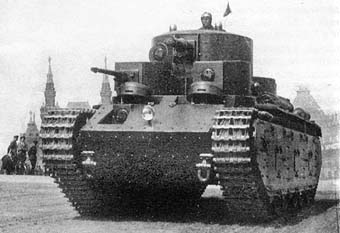
The T-35-2 prototype was completed in April 1933 and displayed at the May Day parades in Leningrad, stunning the crowds with its fearsome array of weapons. However, at the same time, OKMO was already busy drawing up plans for the production version of the tank, known as the T-35A.
This vehicle was very different from the previous T-35-1 and T-35-2, with the entire chassis being extended and receiving an extra suspension bogie on each side. It also received new secondary turrets, and the 37 mm guns were swapped with 45 mm guns.
The Kharkov Locomotive Plant in Ukraine became responsible for the tank’s production, but due to the T-35A essentially being a new design, its manufacture was plagued with issues. Production started near the end of 1933, and by the end of 1934 a total of 12 had been built.
The Kharkov Locomotive Plant encountered serious issues with the vehicle, which they tried to solve themselves as production progressed. The M-17 was prone to overheating, and the transmission was still unreliable.
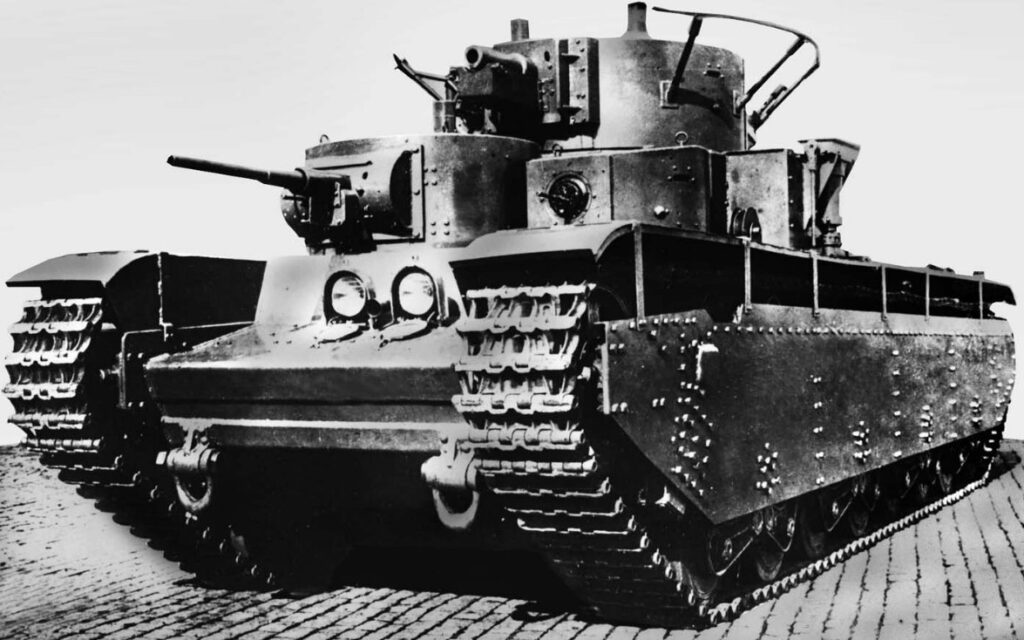
This led to an extremely complex production run that lasted until 1939, with no more than 15 ever being built in a single year during that time. Due to modifications during the production run, most vehicles were built slightly differently from each other.
Due to similarities with Britain’s A1E1, it is often said that the T-35 was a copy of that tank. Soviet sources argue this, however, stating that no documents have been found that prove this happened. So while the T-35 is not a direct copy of Britain’s design, it was likely at least partially influenced by it.
The T-35
Defining the T-35 into a single specification is difficult as most have their own unique features, but they all followed the same basic design, with five turrets on top of a long hull.
The central turret housed a KT-28 76.2 mm howitzer, the same type used on the smaller T-28. Next to this was a 7.62 mm machine gun in a ball mount. Inside the turret was three crewmembers; the commander, a gunner and a loader.
In front of the central turret was two smaller turrets. On the left side was a machine gun turret that housed a single gunner who operated a 7.62 mm machine gun. The right-side turret contained a 45 mm 20K cannon, a 7.62 mm machine, a gunner and a loader.
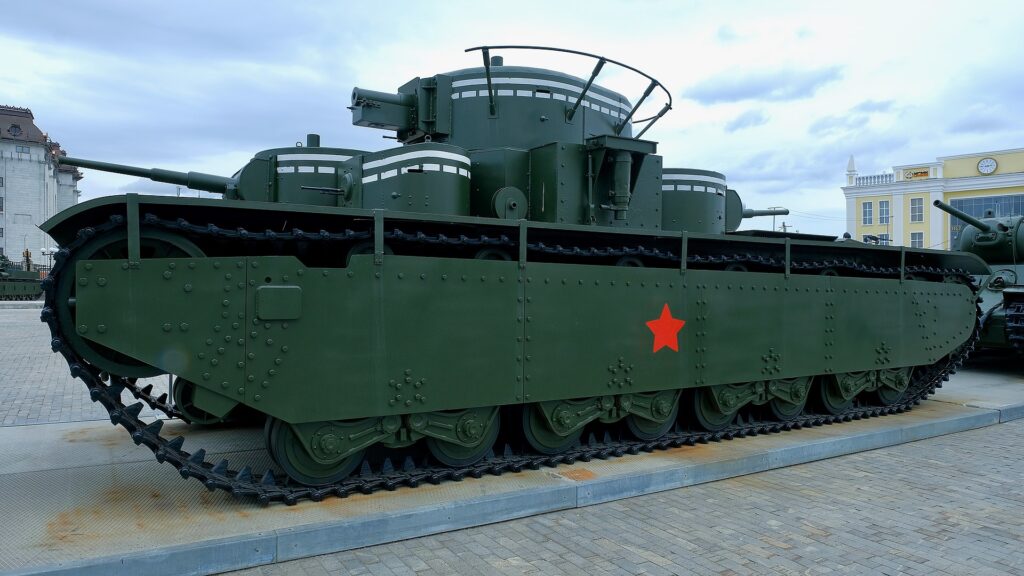
This exact same arrangement was duplicated behind the turret, except the cannon turret was on the left side of the tank and the machine gun turret was on the right side.
The driver was located at the front, along with his controls and compressed air tanks for starting the engine. In total, the tank was crewed by 10 men; a number that could be increased to 12 with the addition of two mechanics.
Inside more than 10,000 machinegun rounds were carried, along with nearly 100 rounds for the 76.2 mm main weapon and 230 rounds for the 45 mm guns. Surprisingly, the T-35’s main turret could be traversed electronically, with a full 360-degree rotation taking 7.4 seconds at maximum speed.
The gunner had a series of lightbulbs on a panel nearby that showed the hatch positions of each turret. This prevented the main turret from rotating and colliding with crewmembers maneuvering through the hatches.
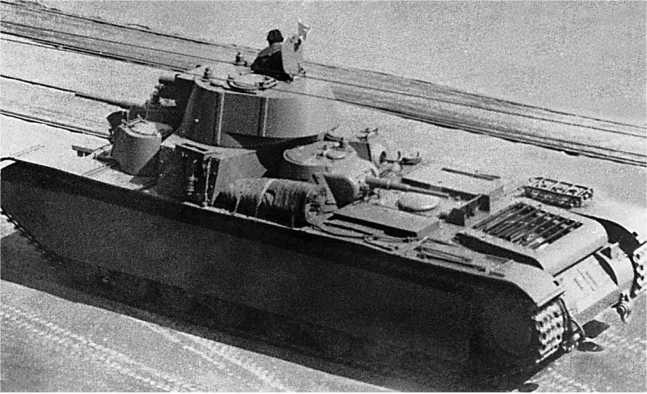
Surrounding the main turret was an antenna for the radio – which also doubled as a handrail – and on both sides were smoke discharger boxes attached the hull.
The T-35 was physically enormous and is one of the largest tanks to have ever entered production. At 9.7 meters (31 ft 11 in), the T-35 is even longer than the TOG 2! But its width of 3.2 meters (10 ft 6 in) is disproportionately thin, so the T-35 was likely difficult to steer. It was extremely tall too, being almost half a meter taller than the Tiger II.
Compared to its immense firepower, the T-35’s armor protection looks a little lacking. The front of the hull had the most armor at 30 mm thick. Most other areas, including the sides and rear were 20 mm thick. The sides of the hull had a little extra armor thanks to the 10 mm plating covering the suspension. The smaller turrets ranged from 15 to 22 mm thick, and had 10 mm thick roofs.
To be fair to the T-35, this was not too bad for 1933 standards. Due to its size, it would have been virtually impossible to cover the T-35 with more armor without it becoming absurdly heavy.

At 52 tons it was one of the heaviest tanks of its day – which is no surprise considering how big it was.
As mentioned, the T-35 was powered by a 500 hp Mikulin M-17 V12 petrol engine, a Soviet-built version of the German BMW VI aircraft engine. The engine and transmission were located at the back of the tank. A large fan mounted horizontally above the transmission provided cooling air for the engine’s radiators.
With this engine, the T-35 was able to reach a top speed of 17 mph on road, and nearly 9 mph off-road.
Service and Fate
Production of the T-35 was slow, with only 7 being built in 1935 and 15 in 1936. Complaints and issues with the T-35 had gotten so bad that in 1936 a vehicle was pulled out and subjected to intensive testing near Kharkov to try and figure out some of its problems.
19 months, 2,000 km, three engines, and a whole host of breakdowns later, the T-35’s problems had been identified. As seen since the beginning of the project, the main issues were related to its engine overheating, and the reliability of the transmission and gearbox.
A large list of changes were made to the design, resulting in vehicles produced from 1937 onwards being much more reliable. This wouldn’t have a major impact though, as only 10 were built in 1937, and 11 in 1938.
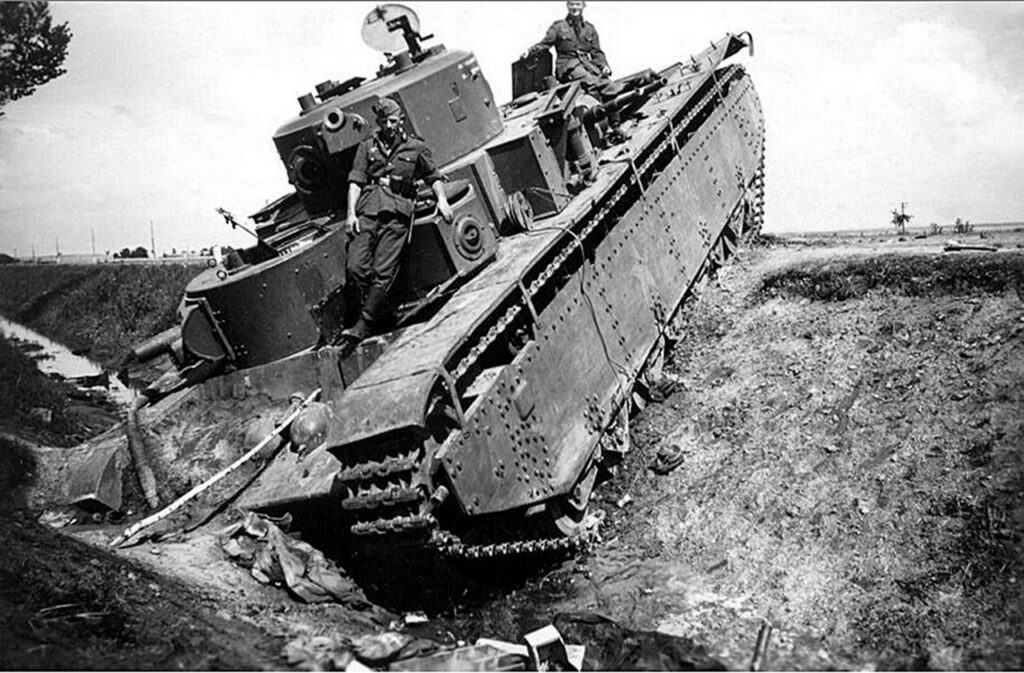
Soviet officials also realized that the T-35’s armor was completely inadequate to serve as a breakthrough tank, so work began on trying to up-armor the tank. However by this time much more advanced vehicles were in development, particularly the T-100 and SMK heavy tanks.
These vehicles were designed as modern successors to the T-35, with two turrets, much thicker armor and more powerful guns. While these tanks wouldn’t enter service, a single-turreted version of the SMK would arrive in 1938. This would become the famous KV-1.
Against these vehicles the T-35 simply could not compete, and its production was canceled in 1939. In total, over the entirety of the T-35 project, 2 prototypes and 61 production tanks were built.
Despite its production being canceled, the T-35 remained in service with the Red Army. In practice, the tank was regularly brought out to amaze spectators at military parades through cities like Moscow. Bristling with guns, the T-35 was a formidable propaganda weapon.
It is often stated that the T-35 fought the Finns during the Winter War, but this is untrue, as the type did not see any combat before the start of Operation Barbarossa (Germany’s invasion of the USSR).

Almost every single T-35 was lost during the invasion, with most of those succumbing to mechanical issues rather than being knocked out in battle.
So after a decade since it was first conceived, the tank proved itself to be almost completely useless when actually used in combat. Its size, slow speed, mechanical unreliability and thin armor doomed the tank. Then, tanks like the KV-1 and T-34 made the T-35 completely obsolete.
But, likely the biggest issue with the T-35 was its main feature: the multi-turret design. As Britain had found out in the 1920s, multi-turreted tanks overloaded the commander and made directing the tank nearly impossible. This is what the Soviets encountered with this landship, and its performance suffered as a result.
The quest to replace this tank resulted in the KV-1, which evolved into the IS family of heavy tanks that would stay in service all the way through the Cold War and serve at the same time as vehicles like the M1 Abrams and Leopard 2.
Today only a single T-35 remains, and it lives at the Kubinka Tank Museum in Russia. Incredibly, the tank is kept in running condition.